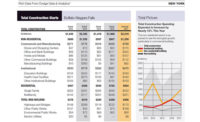...configured as long rectangles with side walls lined with controlled louvers. When the louvers are opened, natural ventilation and the server fans draw cool outside air into the building to a “cold aisle.”

Equipment racks housing servers run along the length of the building on both sides, parallel to and with server fronts facing the cold aisles. Fans on the servers draw cool air from the cold aisle across the servers and exhaust it out the back of the units to a “hot aisle” that runs down the center of the building and is open to the roof.
The high-pitched roof is designed with a cupola that extends the length of the pod. Side walls of the cupola are equipped with controlled louvers. Warm air exhausted into the hot aisle rises and is vented through the louvers in the roof cupola.
“We are taking advantage of the natural laws of thermodynamics with heat rising and evacuating out of the building in essence by a center chimney,” Noteboom says. “The cold aisle is tied into a plenum that draws in air from the outside.”
Auxiliary fans aid in the process as required, Deneny says. “But not anything close to what you would see in larger data centers.”
When Lockport gets hot, on average about 212 hour per year, the data center will run an evaporative cooling system. “We have innovated a more modern version of the swamp cooler,” Noteboom explains.
During periods of extreme cold the heat from the UPS (uninterrupted power supplies) systems, located in each pod, along with the heat generated by the computer equipment will warm the facility.
While the design is innovative for a data center, the design principles can be found in historic industrial facilities in the Buffalo area, Noteboom says. These historic structures were oriented to take advantage of the prevailing winds from the lakes and used outside air for cooling. “Back then refrigerant cooling did not existing.”
“We are applying lessons that were learned during the industrial revolution in Buffalo to a modern data center, which is a new industry in Buffalo,” he says. “I think that’s kind of cool.”
Noteboom estimates the PUE (Power Usage Effectiveness) of the new center at 1.08. PUE is defined as the total power used by the data center divided by the power used by the IT equipment.
The average PUE for data centers in 2006 was 2.0 or higher, according to the U.S. EPA. This means that for every...


Post a comment to this article
Report Abusive Comment